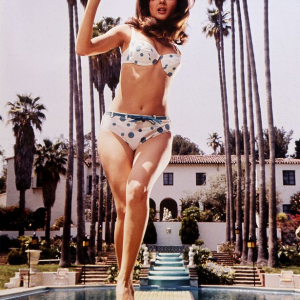Some women are remembered only for their looks, but others are etched into history for their courage. Miki Garcia belongs to the latter. With her radiant smile and magnetic presence, she lit up the 1970s as one of Pl*yboy’s most memorable faces. But behind the glamour, she carried stories that would one day shatter illusions about an empire built on fantasy.

From Arizona Roots to Pageant Fame
Born on February 17, 1947, in Kingman, Arizona, Miki grew up as the daughter of a U.S. Air Force officer. Her childhood was a whirlwind of change — moving from Japan to Germany, Panama to Hawaii, and across the United States. Constant relocation shaped her resilience and gave her a worldly perspective few teenagers could imagine.
Video : Pla*boy Magazine recruiting at SDSU 1978
Pl*yboy Fame in the 1970s
In January 1973, Miki Garcia became Pl*yboy’s Pla*ymate of the Month. Her classic curves, confidence, and magnetic personality won over readers instantly. From there, her career exploded. She appeared in magazine spreads, television spots, and even movies like Stacey (1973) and Kill the Golden Goose (1974).
But Miki wasn’t content to be just another face on glossy pages. She created her own crochet bikini line, cheekily named “Mikinis,” supporting local women in her community who handmade each piece. It was one of many signs that she was more than just a model — she was a visionary with ambition beyond the lens.
Inside the Pl*yboy Empire

Unlike many Pl*ymates who faded after their centerfold, Miki went deeper into the Pl*yboy machine. She became Director of Promotions and later Vice President of Promotions, organizing high-profile events and managing publicity.
But life in the Pl*yboy Mansion wasn’t all glitter and champagne. Behind the parties and celebrity appearances, Miki saw troubling patterns. Some nights blurred into drugs, exploitation, and pressures hidden from the public eye. While she worked hard to keep up the glamorous image, she couldn’t ignore the shadows lurking beneath.
The Testimony That Shook Pl*yboy

In 1985, Miki did something few dared to do — she spoke out. Testifying before the Attorney General’s Commission on Pornography, she exposed what really happened behind the Mansion doors. She described how women were pressured, exploited, and often silenced, even as the world celebrated Pl*yboy as glamorous freedom.
Video : The Freedom of Pl*yboy | Secrets of Pl*yboy | Mondays at 9pm on A&E
Pl*yboy dismissed her as a “disgruntled former insider,” but her words left a permanent mark. Decades later, her testimony would resurface in the 2022 documentary Secrets of Pl*yboy, where she bravely shared more about the abuse and trauma she had witnessed — and endured. By lifting the veil, she gave other women the courage to come forward.
Life After Pl*yboy: Reinvention and Renewal

Leaving Pl*yboy in the early 1980s, Miki Garcia could have chased Hollywood fame. Instead, she reinvented herself. She built a thriving career in real estate in California, trading flashing cameras for contracts and community trust. For Miki, success became about independence and stability rather than spectacle.
She also sought healing away from the spotlight, focusing on building a quieter, balanced life. Though she keeps her family life private, her later years show a woman who found peace outside the chaos of fame.
The Lasting Legacy of Miki Garcia

To some, Miki Garcia will forever be the dazzling January 1973 Pl*ymate, the brunette beauty who lit up an era. But her deeper legacy lies in what came after. She became a truth-teller, exposing the cost of glamorized freedom and revealing the darker corners of an industry that thrived on silence.
She proved that an icon can be both glamorous and courageous. She showed that beauty might open doors, but honesty and resilience are what leave a lasting impact.
Conclusion: More Than Just a Pl*ymate

Miki Garcia’s story is not just about glossy photos or Hollywood cameos. It’s about resilience, bravery, and reinvention. From an Air Force child to a beauty queen, from a celebrated Pl*ymate to a whistleblower, she lived a life that defied stereotypes. Today, her legacy reminds us that true power isn’t about image — it’s about the courage to speak the truth.


